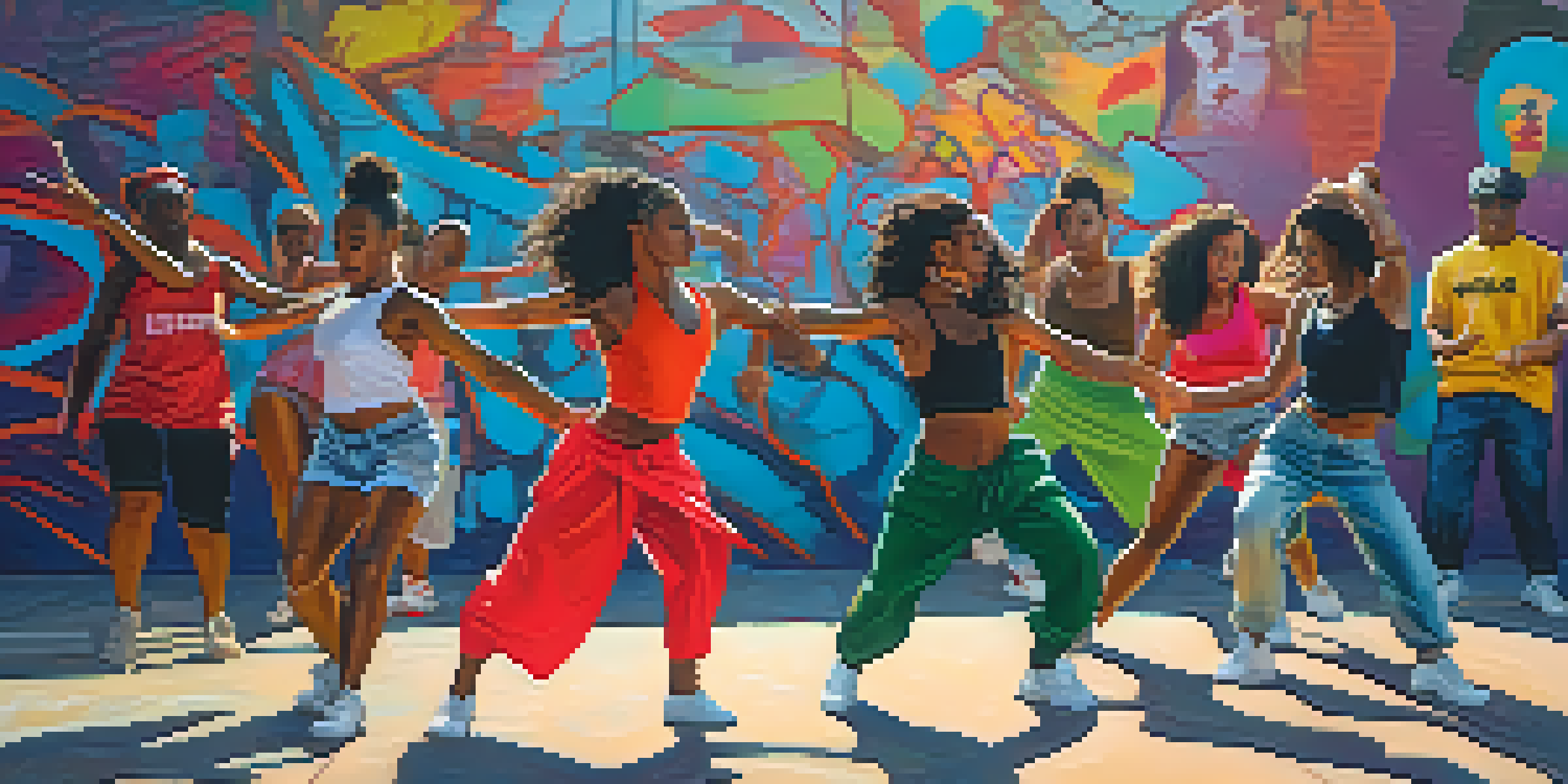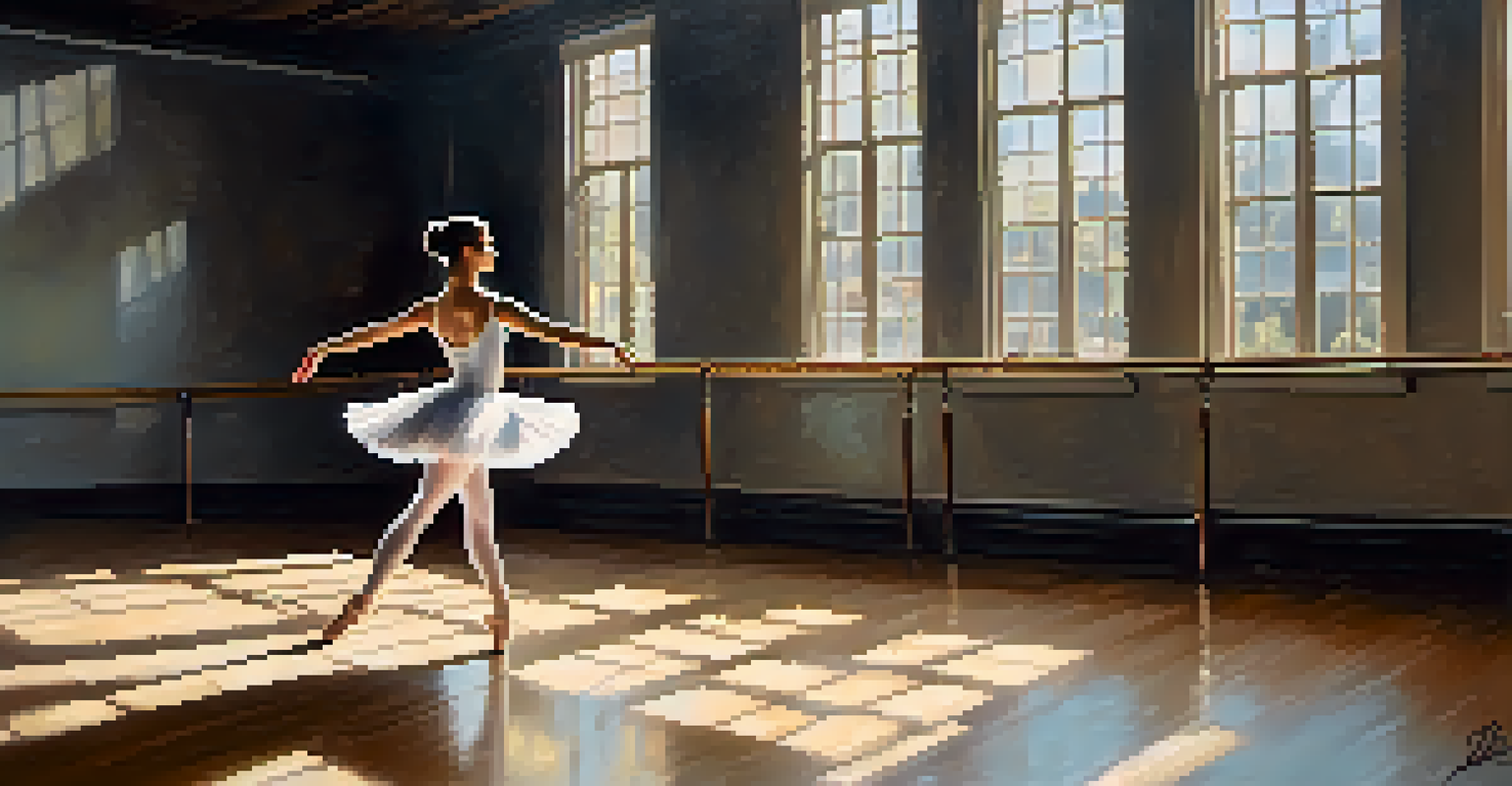Dance as a Tool for Social Commentary in Modern Cinema

The Role of Dance in Storytelling and Expression
Dance has long been a powerful medium for storytelling, transcending spoken language. In modern cinema, filmmakers often use dance to convey emotions and themes that might be difficult to articulate through dialogue alone. For instance, a passionate dance sequence can express love, conflict, or even societal struggles, resonating deeply with audiences.
Dance is the hidden language of the soul.
Consider the iconic dance scenes in films like 'West Side Story,' which vividly depict the tensions between rival gangs through choreography. This not only enhances the narrative but also provides insight into the characters’ inner lives. By moving their bodies, dancers can showcase feelings of joy, despair, and hope in a way that words sometimes fail to capture.
Ultimately, this form of expression allows filmmakers to connect with viewers on a visceral level, making the dance not just an artistic choice but a vital narrative tool.
Dance as a Reflection of Cultural Issues
In many films, dance serves as a mirror reflecting cultural and societal issues. For example, movies like 'Black Swan' delve into themes of obsession and identity within the competitive world of ballet, using dance to illustrate these complex dynamics. The physicality of dance becomes a symbol of the struggles individuals face in pursuit of perfection.

Furthermore, dance can highlight cultural identities, as seen in films like 'Step Up' or 'Dirty Dancing.' These films not only celebrate diverse dance styles but also showcase the challenges faced by different communities in expressing their cultural heritage. Through dance, filmmakers can address issues of race, class, and gender, creating a dialogue around these important topics.
Dance Enhances Storytelling
Filmmakers utilize dance to convey emotions and themes that enrich narratives beyond the limits of dialogue.
By incorporating dance into their narratives, filmmakers can foster greater awareness and understanding of cultural issues, encouraging audiences to reflect on their own experiences.
Choreography as Political Protest
Dance has also emerged as a potent form of political protest in modern cinema. Filmmakers harness the power of movement to challenge societal norms and injustices, using dance as a form of rebellion. For instance, the film 'Selma' features a powerful sequence where dance communicates the struggle for civil rights, illustrating the resilience and determination of activists.
The body says what words cannot.
These choreographed moments serve not only to entertain but to inspire action and provoke thought, pushing audiences to consider the deeper implications of what they are witnessing. By integrating political themes into dance, films encourage viewers to engage with important social issues on a more personal level.
In this way, dance becomes a catalyst for change, serving as a reminder that art can challenge the status quo and inspire a collective response.
The Evolution of Dance in Film: A Historical Perspective
To fully appreciate dance as a tool for social commentary in cinema, it's essential to explore its historical evolution. From the early days of silent films, where dance was a prominent entertainment form, to the golden age of musicals, dance has continued to adapt and reflect societal changes. Each era brought new styles and themes that mirrored the cultural landscape.
For example, the jazz age introduced energetic dance sequences that celebrated freedom and rebellion, while the disco era showcased a sense of community and expression. These shifts in dance styles often paralleled broader social movements, illustrating how filmmakers respond to the changing tides of society.
Cultural Reflection Through Dance
Dance serves as a mirror to cultural and societal issues, fostering dialogue around race, class, and identity.
As a result, understanding this evolution helps us recognize how dance has remained relevant as a means of social commentary, adapting to address contemporary issues while drawing on its rich history.
Iconic Dance Scenes and Their Social Messages
Certain dance scenes in modern cinema have left an indelible mark, not only for their artistry but for the social messages they convey. Take, for instance, the 'This Is America' music video by Childish Gambino, which employs striking choreography to address gun violence and racial issues in the United States. The juxtaposition of joyous dance with dark themes creates a powerful commentary that lingers long after the performance ends.
Similarly, the film 'Footloose' tackles themes of censorship and freedom through its dance sequences, highlighting the importance of self-expression. These scenes often resonate with audiences because they encapsulate complex social issues in a relatable and visually engaging manner.
By examining these iconic moments, we gain insight into how dance can serve as a vehicle for powerful social commentary, inviting viewers to reflect on the world around them.
The Impact of Dance on Audience Perception
Dance influences audience perception in unique and profound ways. When viewers watch a character express themselves through dance, it can evoke empathy and understanding, allowing them to connect emotionally with the narrative. This emotional connection often leads to a deeper awareness of the social issues being presented.
For instance, the visceral energy of a dance performance can provoke a sense of urgency regarding topics like mental health, poverty, or inequality. As audiences witness the struggles and triumphs articulated through movement, they may be compelled to reflect on their own beliefs and attitudes.
Dance as Political Protest
Choreographed movements in cinema can challenge societal norms and inspire action, using dance as a form of rebellion.
Consequently, dance not only entertains but also educates, challenging viewers to rethink their perspectives and engage with the world more critically.
Future Directions: Dance and Social Commentary in Cinema
As we look to the future, the role of dance in cinema as a tool for social commentary is likely to grow even more significant. With the rise of digital platforms, filmmakers have more opportunities to experiment with innovative dance styles and narratives that address contemporary social issues. This evolution could lead to a more diverse representation of voices and experiences in film.
Moreover, as social movements continue to gain traction, we can expect filmmakers to leverage dance as a means of expressing solidarity and advocating for change. The global nature of dance allows for cross-cultural collaborations that can amplify important messages, fostering a sense of unity among audiences worldwide.

Ultimately, the future of dance in cinema holds the promise of deepening our understanding of social issues, encouraging us to move together toward a more inclusive and empathetic society.